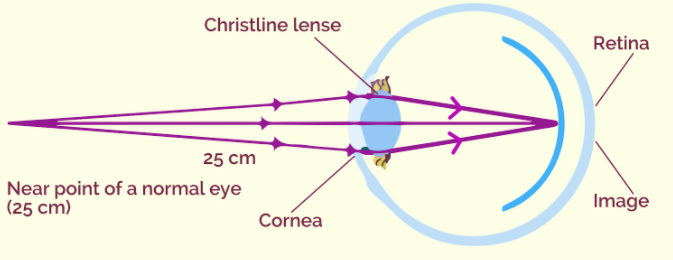
Near point of human eye is
(a) 25cm
(b) 20cm
(c) 15cm
(d) 10cm
Answer
567.9k+ views
Hint: The near point of the eye is defined as the minimum distance at which a normal eye can see the objects clearly without any strain. The minimum distance at which a human eye can see clearly without strain or the near point is close to 1 foot.
Complete step by step answer:
The human eye can see objects clearly without any strain on the eye when an object is placed at least 25 cm away. This distance of 25 cm is known as the near point of the eye. When the object is placed at a distance between 25 cm and infinity, the image of the object is formed on the retina and interpreted clearly. If an object is placed closer than 25 cm, an image is formed behind the retina and hence strains the eye and is not clear.
Additional Information:
The near point may sometimes vary because of certain conditions of the eye called myopia and hypermetropia.
 For example: In a myopic eye, the near point is closer than the average distance whereas in hypermetropia the near point is further away.
For example: In a myopic eye, the near point is closer than the average distance whereas in hypermetropia the near point is further away.
So, the answer is, “25cm”.
Note:
- This near point can sometimes be written in the form of power or dioptres. 1D or 1 dioptre = $\frac { 1 }{ 1metre }$ So near point is $\frac { 1 }{ 25 cm }$ =$\frac { 1 }{ 0.25 m }$ =${ 4D }$
- The human eye can adjust according to the distance of the object from the eye to look at the objects. - This is called the power of accommodation. - The ciliary muscles adjust the diameter of the lens to achieve this.
Complete step by step answer:
The human eye can see objects clearly without any strain on the eye when an object is placed at least 25 cm away. This distance of 25 cm is known as the near point of the eye. When the object is placed at a distance between 25 cm and infinity, the image of the object is formed on the retina and interpreted clearly. If an object is placed closer than 25 cm, an image is formed behind the retina and hence strains the eye and is not clear.
Additional Information:
The near point may sometimes vary because of certain conditions of the eye called myopia and hypermetropia.

So, the answer is, “25cm”.
Note:
- This near point can sometimes be written in the form of power or dioptres. 1D or 1 dioptre = $\frac { 1 }{ 1metre }$ So near point is $\frac { 1 }{ 25 cm }$ =$\frac { 1 }{ 0.25 m }$ =${ 4D }$
- The human eye can adjust according to the distance of the object from the eye to look at the objects. - This is called the power of accommodation. - The ciliary muscles adjust the diameter of the lens to achieve this.
Recently Updated Pages
Master Class 11 Business Studies: Engaging Questions & Answers for Success

Master Class 11 English: Engaging Questions & Answers for Success

Master Class 11 Computer Science: Engaging Questions & Answers for Success

Master Class 11 Social Science: Engaging Questions & Answers for Success

Master Class 11 Maths: Engaging Questions & Answers for Success

Master Class 11 Biology: Engaging Questions & Answers for Success

Trending doubts
Differentiate between an exothermic and an endothermic class 11 chemistry CBSE

One Metric ton is equal to kg A 10000 B 1000 C 100 class 11 physics CBSE

Explain zero factorial class 11 maths CBSE

Why is steel more elastic than rubber class 11 physics CBSE

State the laws of reflection of light

What is 1s 2s 2p 3s 3p class 11 chemistry CBSE




